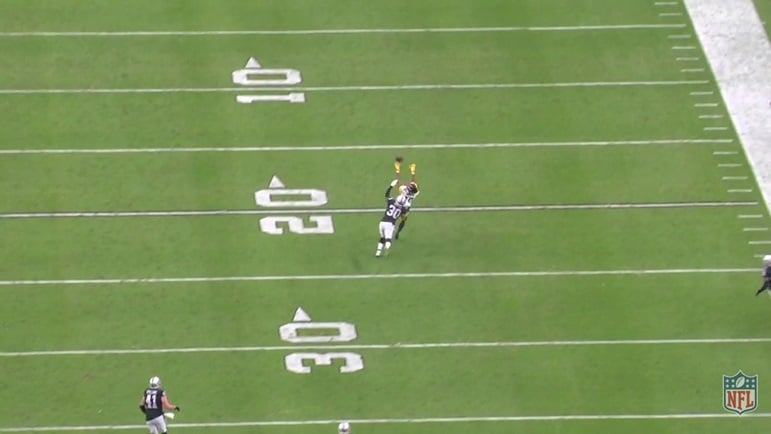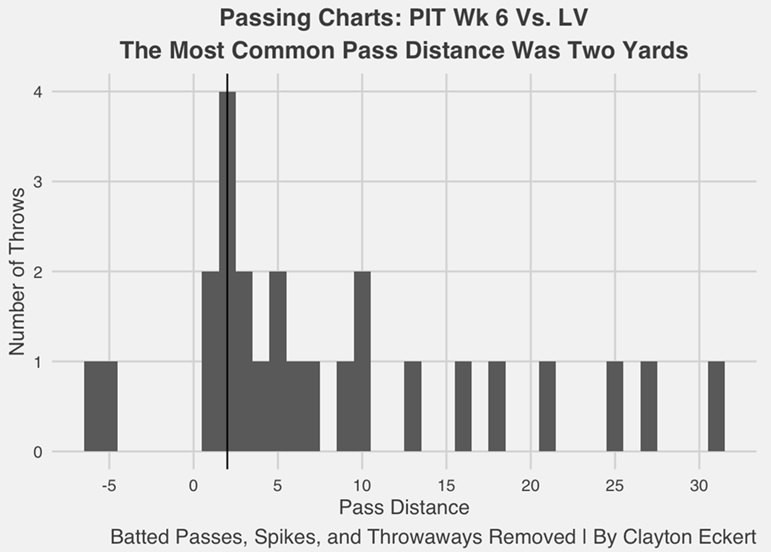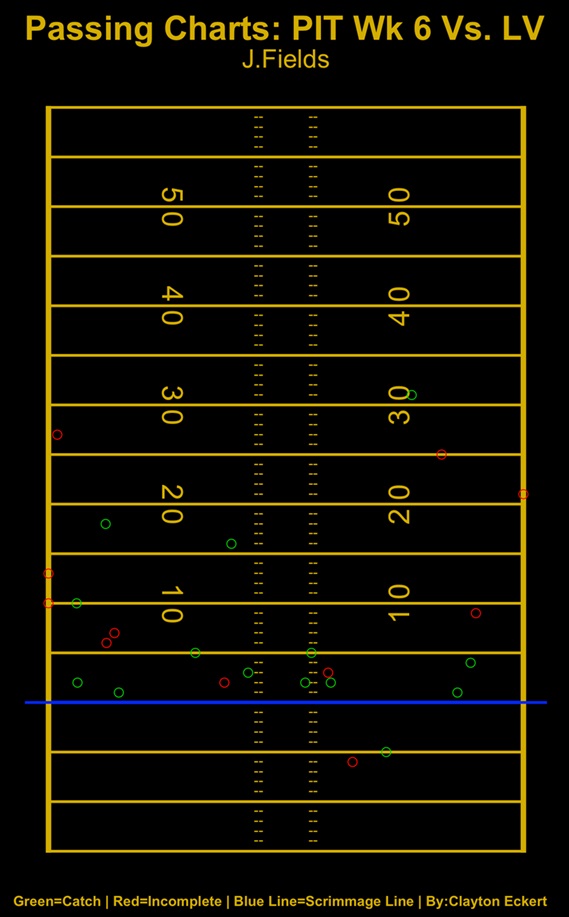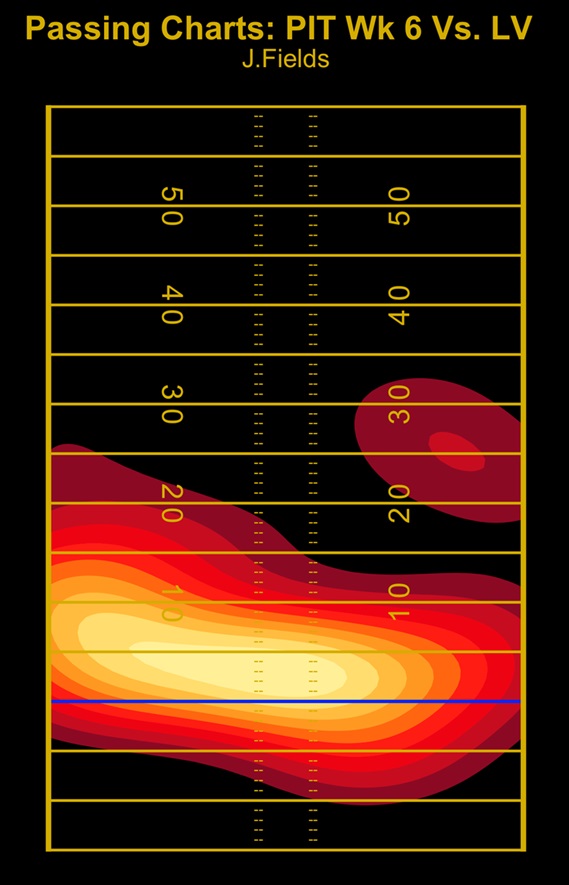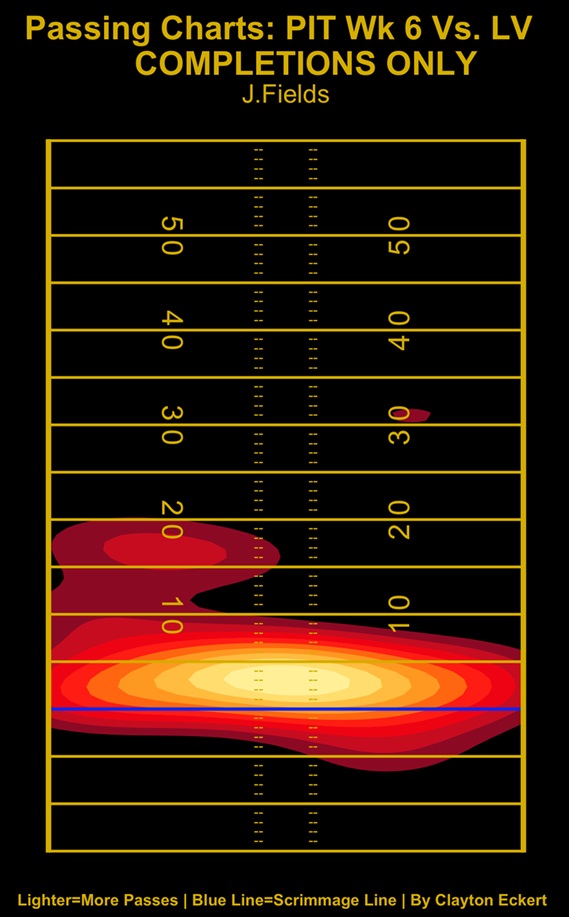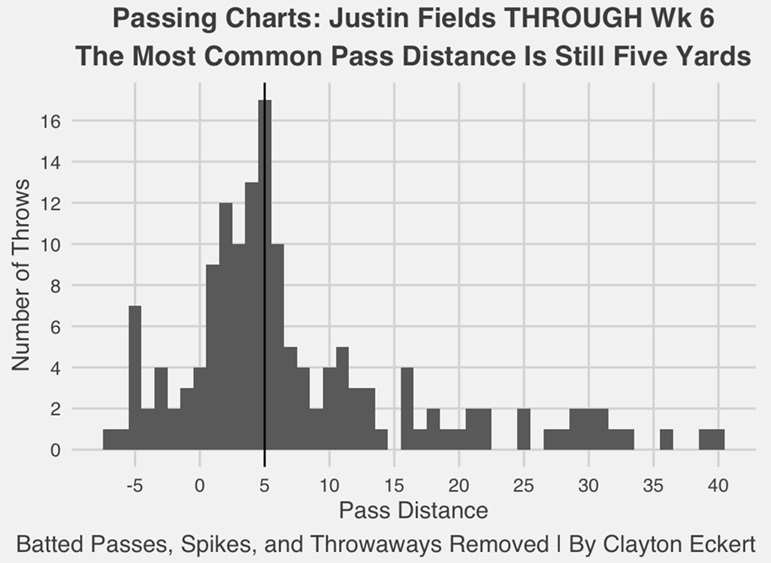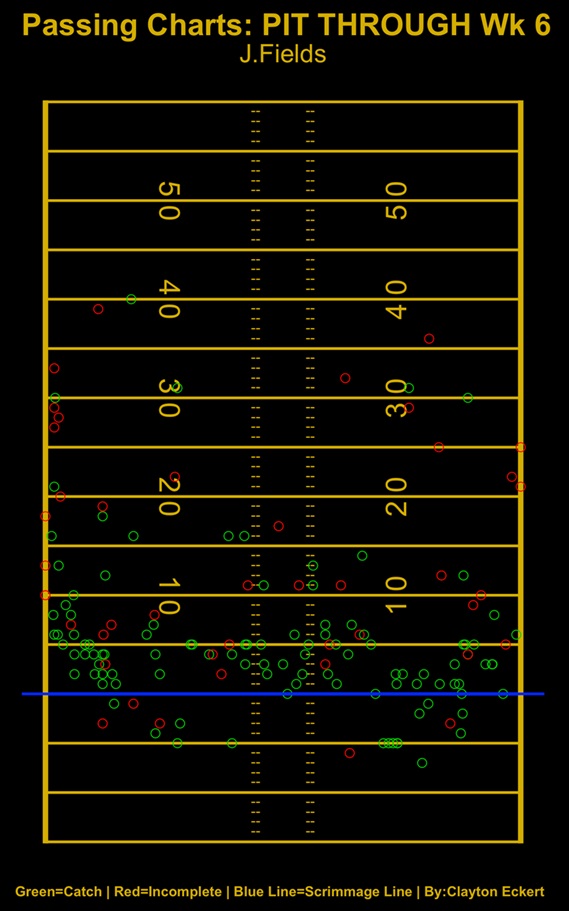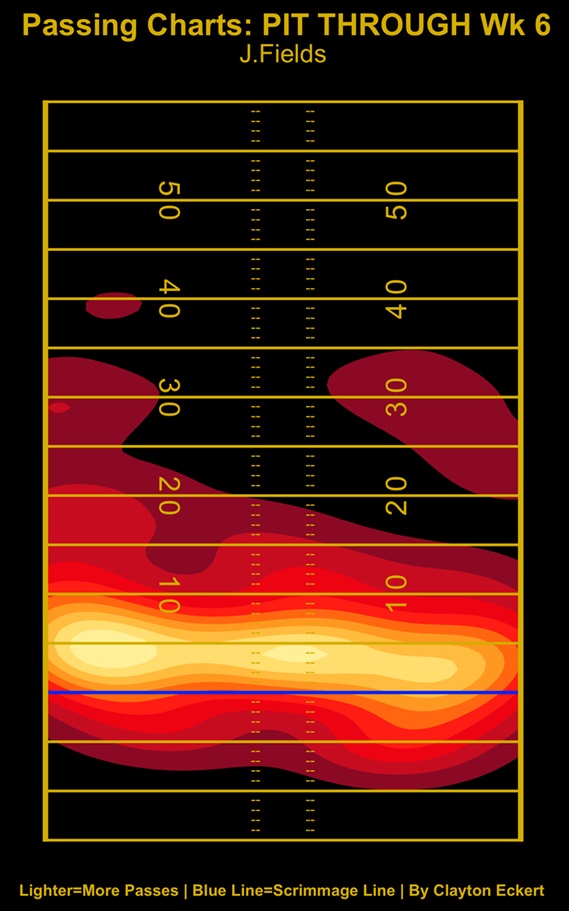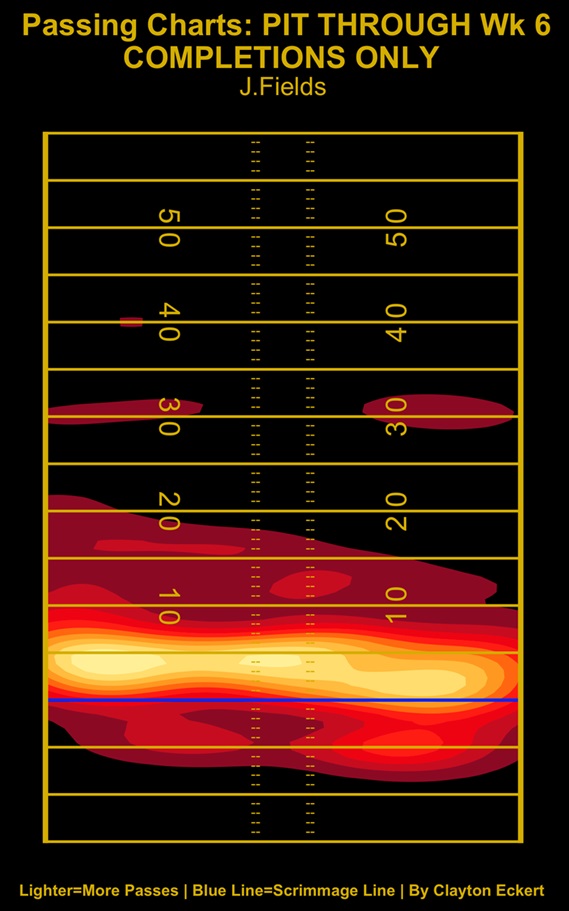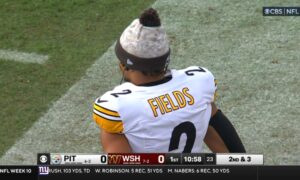The Pittsburgh Steelers are now 4-2, getting back in the win column despite another slow start with issues on both sides of the ball. Thankfully they picked it up in the second half and scored an unusually comfortable 32-13 win against the wounded Las Vegas Raiders. Today, let’s examine the Steelers’ the passing performance.
Couple of notes before we jump in. Thanks to Thomas Mock for his great work that helped me learn much of what I’m using in the series visually. Spikes and clear throwaways are removed due to being the correct situational decision, along with bats at the line of scrimmage. One throwaway this game, along with two passes that don’t make the stat sheet: a two-point conversion attempt and a backward pass.
QB Justin Fields went 14-of-24 (58.3-percent completion rate), his second week in a row with a sub-60 percentage. Just 145 passing yards, his third game of the year under 150. No passing touchdowns or interceptions, though he had three near-picks. Accuracy, decision-making, and reading the defense were worst of the season. Three sacks and a season-high 20 pressures on him had a lot to do with that but not all-encompassing.
This led to lots of moving the pocket and scrambling, including 59 rushing yards and 5.9 YPA were season highs, along with tying for a game best two rushing TDs. Thankfully this married with a monster game, namely RB Najee Harris, and wouldn’t have enjoyed the offense finally scoring more points otherwise.
Another Fields bugaboo was three penalties: two delay of games and an illegal forward pass, crossing the line of scrimmage negating a would-be passing TD. Though the scoreboard said otherwise, plenty of messiness from the offense and Fields that has to improve to be competitive against top teams.
Let’s start with a simple view of the 25 charted passes, with number of throws at each pass distance for Week 6:
#1. 0-5 air-yards: 44.0-percent. Most common, as usual. The first pass of the game was a wide-open stop over the middle to Harris, catching it at 2 air-yards with plus YAC and churn which was an awesome theme for an 11-yard gain. A 2nd and 9 shortly after was TE Pat Freiermuth sitting in an open spot at five air yards, with a bit of churning YAC for eight.
The opening drive ended with a 3rd and 15, taking a flat well short of the sticks to RB Jaylen Warren (gaining negative yardage the prior two plays), wide-open but only able to get eight yards on the fail and settling for the FG.
Another negative situation was a 2nd and 20 (TE Connor Heyward false start and Harris loss of five). Conservative stop to Freiermuth at 5 air yards and 8-yard gain, and I noted open receivers downfield.
Drive three example was a rare third-and-manageable (3rd and 3) where Fields extended and moved the pocket, finding WR George Pickens who worked open towards the sideline at 4-air yards and gain of seven. Nice pitch and catch conversion.
Next was a flat to Heyward at 2 air yards near the sideline, churning out of bounds for 4-yards. Later in the drive on 2nd and 16, another sit to Harris over the middle, taking the high percentage checkdown with pressure, noting he might have found Freiermuth open deeper downfield with more time.
Unfortunately, the drive was dire straits again, a 3rd and 28 due to a failed flea-flicker sack and delay of game. Fields again took a short target, WR Calvin Austin on a shallow crosser at two air yards, where former Steeler Robert Spillane sniffed it out with a big hit that jarred it loose.
Following Fields’ first rushing touchdown before halftime, Pittsburgh went for two up 12-7. A predetermined to throw a slant to Heyward was nearly picked, an example of decision-making and issues reading the defense in this game.
One third quarter example was 3rd and 18. Fields had pressure, getting it to Warren on a swing pass with space, but unable to make a guy miss in the open field for just six yards. Las Vegas bailed the fail out with a roughing the passer though, making it an explosive conversion instead, and eventually Harris’ impressive second TD.
Last example was early fourth quarter, dumping it to TE Darnell Washington at two air yards with a bit of YAC and churn to pick up just enough on 2nd and 9.
#2. 5-10 air-yards: 28.0-percent. Yet to be mentioned was a 3rd and 12 on the unfortunate situation second drive. Didn’t end any better with a drop from Pickens on an intermediate out, hitting his hands and bobbled incomplete. Also, was short of the sticks and even if caught, no guarantee of a conversion.
Following drive early in the second quarter, the offense moved backward again on 2nd and 18. Fields and Pickens made a nice connection on an intermediate stop at ten air yards, sliding around iffy tackling effort along the sideline for YAC. 15 yards and a more manageable third down to follow.
The next 10 air yard example was during a rough accuracy stretch of overthrows on this drive. This one was on 2nd and ten, sailing it over Freiermuth open along the sideline, trying his best Air Jordan jump just to get a hand on it (to no avail).
Last two plays were in the fourth quarter. On 3rd and 11, Fields is pressured (free LB) and the pass hopped short intended for Austin. Even if it was on target, the defender was right there, and possibly turnover-worthy play. After a nice play, Pittsburgh was really trying to get Pickens his first TD of 2024, but instead his second drop of the game on a red zone/end zone missed opportunity.
Several players including Fields had their warts. But receivers, especially your WR1 must step up better than this, including too many drops.
#3. Explosive (20-plus air-yards): 16.0-percent. Four plays. First came late first quarter, unfortunately another Fields overthrow on a deep shot to Pickens at 27 air yards, outstretching over his head off his hands incomplete. 3rd and 10 was another overthrown Fields/Pickens miscue at 21 air yards, on a scramble drill (pressure) that stalled the third drive to a FG.
Later in the second quarter, you guessed it, another overthrow. This one was a slot fade to Austin at 25 air yards, with a bit more grace considering pressure allowed by Broderick Jones. The last example thankfully connected despite more inaccuracy, this one an underthrow to Pickens on a deep crosser at 31 air yards, making a great diving grab late game to seal the victory.
T-4th. 10-15 air-yards: 12.0-percent. One example not discussed yet. Fields is forced to scramble (G Isaac Seumalo pressure), with a horrendous overthrow sliding left, not setting his feet and sailing out of bounds. Yuck.
T-4th. 15-20 air-yards: 12.0-percent. 3rd and 11 second quarter, a scramble drill with better footwork led to a laser to Austin on the intermediate crosser at 18 air yards in a tight window for a nice conversion grab and explosive 20-yard gain.
Austin was also the target on the other third down, where Fields showed great poise in the pocket finding the in-breaker well past the sticks on 3rd and 2 for the conversion. These types of plays show Fields’ ability, but unfortunately far too inconsistent in Week Six.
#6. Behind-the-Line: 8.0-percent. Just two plays. On the second drive, a RB screen to Warren on 2nd and 12 was blown up by the defense for a loss of three, with none of Pittsburgh’s o-line able to get in front in time.
The other was also painful, with Fields throwing a swing high to Warren, jumping but off his hands. Thankfully fantastic hustle led to Warren recovering the backward pass/fumble on 2nd and Goal that allowed a FG a couple plays later. Whew.
Here are the dots of completions/incompletions for the game:
Unfortunately, common theme, namely miscues overall at explosive distances and barely completing any passes further than ten air yards. Three air yard completions past ten yards simply is not enough for consistent winning. Different location issues included less sideline connection and short over the middle, but were more fundamentals than anything.
Completion Rates By Distance:
FIELDS:
Behind-the-line: 1/2 (50-percent).
0-5 air-yards: 9/11 (81.8-percent).
5-10 air-yards: 3/7 (42.9-percent).
10-15 air-yards: 1/3 (33.3-percent).
15-20 air-yards: 2/2 (100-percent).
Explosive: 1/4 (25-percent).
Money at 15-20 air yards with Austin was positive, albeit a small two throw sample, along with a nice rate at 0-5 air yards which is more expected. 50-percent or lower at all other pass distances.
Completion Rates By Location:
FIELDS:
Outside left numbers: 4/9 (44.4-percent).
Left numbers-left hash: 3/4 (75-percent).
Inside hashes: 2/2 (100-percent).
Right hash-right numbers: 2/4 (50-percent).
Outside right numbers: 3/6 (50-percent).
Far less connection than usual outside the numbers, usually high percentage throws for Fields and most QBs. Perfect inside the hashes, but short dump offs at five air yards or less. Good rate left number-left hash, with a 16-air yarder to Austin the only between the numbers completion past five yards.
Now for the heat-maps for charted-passes, then completions only:
Neither chart is inspiring, especially when they look so similar to the ones during the two-game losing streak. This win was in spite of the passing game overall, to be frank, and hopefully can be righted by Fields, or if the performance warrants HC Mike Tomlin to go with QB Russell Wilson. One thing’s for sure, hopefully the passing game improves, and soon.
Next, here’s a data recap of Fields’ 150 charted throws of the 2024 regular season:
#1. 0-5 air yards: 43.3-percent. Previously 43.2-percent. 2023 35.0-percent.
#2. 5-10 air yards: 28.0-percent. Previously 28.0-percent. 2023 23.8-percent.
T-3rd. Behind-the-line: 13.3-percent. Previously 14.4-percent. 2023 18.5-percent.
T-3rd. Explosive: 13.3-percent. Previously 12.8-percent. 2023 12.4-percent.
#5. 10-15 air yards: 10.7-percent. Previously 10.4-percent. 2023 13.0-percent.
#6. 15-20 air yards: 6.0-percent. Previously 5.6-percent. 2023 10.8-percent.
The most common distance is virtually unchanged, and literally the case for 5-10 air yards. Behind the line dipped and explosives rose, creating a tie for third most. While explosive connection has been quite an issue, at least the frequency has rose as the season progresses. Bump ups in the intermediate distances are welcomed as well.
Completion Rates By Distance:
FIELDS:
Behind-the-line: 15/20 (75.0-percent).
0-5 air-yards: 57/65 (87.7-percent).
5-10 air-yards: 30/42 (71.4-percent).
10-15 air-yards: 8/16 (50-percent).
15-20 air-yards: 5/9 (55.6-percent).
Explosive: 6/20 (30.0-percent).
Completion Rates By Location:
FIELDS:
Outside left numbers: 35/53 (66.0-percent).
Left numbers-left hash: 14/20 (70.0-percent).
Inside hashes: 11/13 (84.6-percent).
Right hash-right numbers: 26/33 (78.8-percent).
Outside right numbers: 20/31 (64.5-percent).
To close, here are the dots and heat maps for all charted attempts, then completions only:

